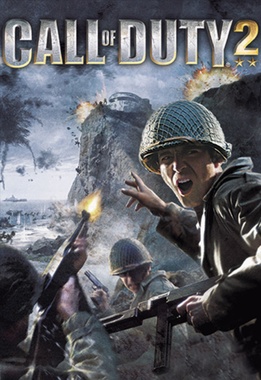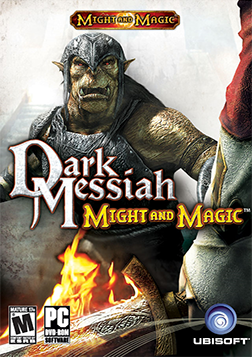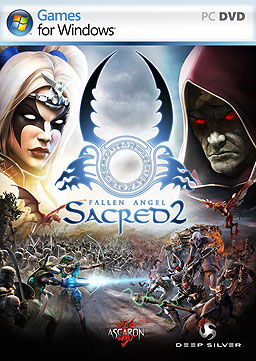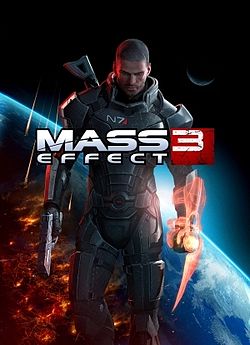
Fallout is a media franchise of post-apocalyptic role-playing video games created by Tim Cain and Leonard Boyarsky, at Interplay Entertainment. The series is set during the first half of the 3rd millennium, and its atompunk retrofuturistic setting and artwork are influenced by the post-war culture of the 1950s United States, with its combination of hope for the promises of technology and the lurking fear of nuclear annihilation. A forerunner of Fallout is Wasteland, a 1988 game developed by Interplay Productions. Fallout is regarded as a spiritual successor to Wasteland.

Quake 4 is a 2005 first-person shooter video game developed by Raven Software and published by Activision. It is the fourth title in the Quake series, after the multiplayer Quake III Arena, and a sequel to Quake II. Raven Software collaborated with id Software, who supervised the development of the game as well as provided the id Tech 4 engine upon which it was built. The game has an increased emphasis on single-player gameplay compared to previous installments; its multiplayer mode does not support playable bots.

Final Fantasy XI, also known as Final Fantasy XI Online, is a massively multiplayer online role-playing game (MMORPG), originally developed and published by Squaresoft and then published by Square Enix as the eleventh main installment of the Final Fantasy series. Designed and produced by Hiromichi Tanaka, it was released in Japan on May 16, 2002, for PlayStation 2 and Microsoft Windows-based personal computers in November of that year. The game was the first MMORPG to offer cross-platform play between PlayStation 2 and PC. It was later released for the Xbox 360 in April 2006. All versions of the game require a monthly subscription to play.

The Elder Scrolls IV: Oblivion is a 2006 action role-playing game developed by Bethesda Game Studios, and co-published by Bethesda Softworks and 2K Games. It is the fourth installment in The Elder Scrolls series, following 2002's The Elder Scrolls III: Morrowind, and was released for Microsoft Windows and Xbox 360 in 2006, followed by PlayStation 3 in 2007. Taking place within the fictional province of Cyrodiil, the game's main story focuses on the player character's efforts to thwart a fanatical cult known as the Mythic Dawn that plans to open portal gates to a demonic realm known as Oblivion.

Call of Duty 2 is a 2005 first-person shooter video game developed by Infinity Ward and published by Activision in most regions of the world. It is the second installment of the Call of Duty series. Announced by Activision on April 7, 2005, the game was released for Microsoft Windows on October 25, 2005, and as a launch title for the Xbox 360 on November 22, 2005. Other versions were eventually released for OS X, mobile phones, and Pocket PCs.

Dark Messiah of Might and Magic is a first-person action role-playing game developed by Arkane Studios. The player controls Sareth, the apprentice of the wizard Phenrig, after he is sent to the city of Stonehelm to accompany an expedition trying to retrieve a powerful artifact known as "The Skull of Shadows".

Lost Planet: Extreme Condition is a third-person shooter video game developed and published by Capcom for Xbox 360, Microsoft Windows and PlayStation 3. The game was released in Japan in December 2006 and worldwide in January 2007. Originally intended to be an Xbox 360 exclusive, it was later ported and released for Microsoft Windows in June 2007 and PlayStation 3 in February 2008.

Eragon is a third-person video game released for PlayStation 2, Xbox, Xbox 360, and Microsoft Windows, developed by Stormfront Studios and published by Vivendi Games. Also released are unique versions of Eragon for the Game Boy Advance, Nintendo DS, PlayStation Portable, and mobile phone handheld gaming systems, primarily developed by Amaze Entertainment.

Uno is a video game based on the card game of the same name. It has been released for a number of platforms. The Xbox 360 version by Carbonated Games and Microsoft Game Studios was released on May 9, 2006, as a digital download via Xbox Live Arcade. A version for iPhone OS and iPod devices was released in 2008 by Gameloft. Gameloft released the PlayStation 3 version on October 1, 2009, and also released a version for WiiWare, Nintendo DSi via DSiWare, and PlayStation Portable. An updated version developed by Ubisoft Chengdu and published by Ubisoft was released for the PlayStation 4 and Xbox One in August 2016, Microsoft Windows in December 2016 and for the Nintendo Switch in November 2017.

The Elder Scrolls IV: Shivering Isles is the second expansion pack for the role-playing video game The Elder Scrolls IV: Oblivion. Announced on January 18, 2007, the expansion was developed, published, and released over the Xbox Live Marketplace by Bethesda Softworks; its retail release was co-published with 2K Games. It was released for Microsoft Windows in a boxed retail edition on March 26, 2007, while the Xbox 360 version was released digitally on the Xbox Live Marketplace. Shivering Isles takes place on the eponymous isles ruled by the Daedric Prince of Madness, Sheogorath. The player becomes Sheogorath's protégé, and together they try to defeat the Daedric Lord of Order, Jyggalag, thus preventing the isles from being destroyed; this main quest can be ignored for as long as the player wishes to interact with the new world. It is often considered to be Bethesda's best expansion, as well as one of the best expansions in video game history.

Battlestations: Midway is a video game developed by Eidos Hungary and released in 2007 for the Xbox 360 and Microsoft Windows. The Mac version of this game was developed by Robosoft Technologies, based out of India and published in July 2008 by Feral Interactive.

Call of Duty 4: Modern Warfare is a 2007 first-person shooter video game developed by Infinity Ward and published by Activision. It is the fourth main installment in the Call of Duty series. The game breaks away from the World War II setting of previous entries and is instead set in modern times. Developed over two years, Modern Warfare was released in November 2007 for the PlayStation 3, Xbox 360, and Microsoft Windows and was ported to the Wii as Call of Duty: Modern Warfare – Reflex Edition in 2009.

Venetica is a 2009 fantasy-themed action role-playing video game developed by Deck13 and published by DTP Entertainment. It was first released in Europe on 4 September 2009 for Microsoft Windows, with ports for the Xbox 360, and PlayStation 3 being released in 2009 and 2010 respectively. Venetica was later re-released for the North American market in January 2011 and distributed by Rombax Games.

Diablo is an action role-playing dungeon crawler video game series developed by Blizzard North and continued by Blizzard Entertainment after the North studio shut down in 2005. The series is made up of four core games: Diablo, Diablo II, Diablo III, and Diablo IV. Expansions include the third-party published Hellfire, which follows the first game; Lord of Destruction, published by Blizzard and released after the second game; and Reaper of Souls, which follows the third game. Additional content is provided through story elements explored in other types of media forms.

Sacred 2: Fallen Angel is an action role-playing game. It is the second in the Sacred video game series. It is a prequel which takes place 2,000 years before the events of Sacred. Like its predecessor, the game takes place in a fantasy setting. A new game engine allows the game to be rendered in perspective correct 3D, while retaining the viewpoint found in older isometric games. Video game designer Bob Bates was involved in its production. Power metal band Blind Guardian wrote the song "Sacred Worlds" as the theme for the game and also make an appearance as characters.

Mass Effect 3 is a 2012 action role-playing video game developed by BioWare and published by Electronic Arts. The third major entry in the Mass Effect series and the final installment of the original trilogy, it was released in March 2012 for Microsoft Windows, Xbox 360, and PlayStation 3. A Wii U version of the game, entitled Mass Effect 3: Special Edition, was later released in November 2012. The game is set within the Milky Way galaxy in 2186, where galactic civilization is invaded by a highly advanced machine race of synthetic-organic starships known as Reapers.
There are five pieces of downloadable content (DLC) for the Bethesda action role-playing video game Fallout 3. Each package of downloadable content adds new missions, new locales to visit, and new items for the player to use. Of the five, Broken Steel has the largest effect on the game, altering the ending, increasing the level cap to 30, and allowing the player to continue playing past the end of the main quest line. The Game of The Year edition of Fallout 3 includes the full game and all five pieces of downloadable content.

Two Worlds II is an action role-playing game developed by Polish developer Reality Pump and published by TopWare Interactive as a sequel to 2007's Two Worlds. It was released on 9 November 2010 in Europe for Microsoft Windows, Mac OS X, Xbox 360 and PlayStation 3, and on 25 January 2011 in North America for the same platforms. Two Worlds II is a real-time role-playing game that takes place in an open fantasy world where players take the role of a single character with whom they can explore and undertake quests.

Assassin's Creed: Brotherhood is a 2010 action-adventure game developed by Ubisoft Montreal and published by Ubisoft. It is the third major installment in the Assassin's Creed series, and the second chapter in the "Ezio Trilogy", as a direct sequel to 2009's Assassin's Creed II. The game was first released on the PlayStation 3 and Xbox 360 in November and December 2010 and was later made available on Microsoft Windows in March and June 2011. A remastered version of Brotherhood, along with Assassins's Creed II and its sequel, Assassin's Creed: Revelations, was released as part of The Ezio Collection compilation for the PlayStation 4 and Xbox One on November 15, 2016, and for the Nintendo Switch on February 17, 2022.

Assassin's Creed IV: Black Flag is a 2013 action-adventure video game developed by Ubisoft Montreal and published by Ubisoft. It is the sixth major installment in the Assassin's Creed series. Its historical timeframe precedes that of Assassin's Creed III (2012), but its modern-day sequences succeed III's own. Black Flag was originally released for PlayStation 3, Xbox 360, and Wii U in October 2013 and a month later for PlayStation 4, Windows, and Xbox One. It was later ported to the Nintendo Switch as part of The Rebel Collection alongside Assassin's Creed Rogue in December 2019. The game was released for Google Stadia in September 2021.




















